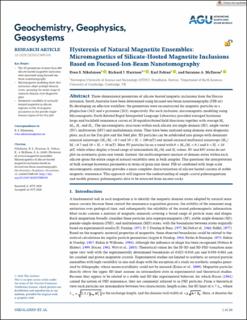| dc.contributor.author | Nikolaisen, Even | |
| dc.contributor.author | Harrison, Richard | |
| dc.contributor.author | Fabian, Karl | |
| dc.contributor.author | McEnroe, Suzanne | |
| dc.date.accessioned | 2021-05-10T10:51:41Z | |
| dc.date.available | 2021-05-10T10:51:41Z | |
| dc.date.created | 2021-01-17T12:38:37Z | |
| dc.date.issued | 2020 | |
| dc.identifier.citation | Geochemistry Geophysics Geosystems. 2020, 21 (11), . | en_US |
| dc.identifier.issn | 1525-2027 | |
| dc.identifier.uri | https://hdl.handle.net/11250/2754614 | |
| dc.description.abstract | Three‐dimensional geometries of silicate‐hosted magnetic inclusions from the Harcus intrusion, South Australia have been determined using focused‐ion‐beam nanotomography (FIB‐nt). By developing an effective workflow, the geometries were reconstructed for magnetic particles in a plagioclase (162) and a pyroxene (282), respectively. For each inclusion, micromagnetic modeling using Micromagnetic Earth Related Rapid Interpreted Language Laboratory provided averaged hysteresis loops and backfield remanence curves of 20 equidistributed field directions together with average Ms, Mrs, Hc, and Hcr. The micromagnetic structures within each silicate are single‐domain (SD), single‐vortex (SV), multivortex (MV) and multidomain states. They have been analyzed using domain‐state diagnostic plots, such as the Day plot and the Néel plot. SD particles can be subdivided into groups with dominant uniaxial anisotropy (Mrs/Ms ∼0.5 and 10 < Hc < 100 mT) and mixed uniaxial/multiaxial anisotropy (Mrs/Ms ∼0.7 and 10 < Hc < 30 mT). Most SV particles lie on a trend with 0 < Mrs/Ms < 0.1 and 0 < Hc < 10 mT, while others display a broad range of intermediate Mrs/Ms and Hc values. SV and MV states do not plot on systematic grain‐size trends. Instead, the multicomponent mixture of domain states within each silicate spans the entire range of natural variability seen in bulk samples. This questions the interpretation of bulk average hysteresis parameters in terms of grain size alone. FIB‐nt combined with large‐scale micromagnetic simulations provides a more complete characterization of silicate‐hosted carriers of stable magnetic remanence. This approach will improve the understanding of single‐crystal paleomagnetism and enable primary paleomagnetic data to be extracted from ancient rocks. | en_US |
| dc.language.iso | eng | en_US |
| dc.publisher | American Geophysical Union, AGU | en_US |
| dc.rights | Navngivelse 4.0 Internasjonal | * |
| dc.rights.uri | http://creativecommons.org/licenses/by/4.0/deed.no | * |
| dc.title | Hysteresis of Natural Magnetite Ensembles: Micromagnetics of Silicate‐Hosted Magnetite Inclusions Based on Focused‐Ion‐Beam Nanotomography | en_US |
| dc.type | Peer reviewed | en_US |
| dc.type | Journal article | en_US |
| dc.description.version | publishedVersion | en_US |
| dc.source.pagenumber | 20 | en_US |
| dc.source.volume | 21 | en_US |
| dc.source.journal | Geochemistry Geophysics Geosystems | en_US |
| dc.source.issue | 11 | en_US |
| dc.identifier.doi | 10.1029/2020GC009389 | |
| dc.identifier.cristin | 1872638 | |
| dc.relation.project | Norges forskningsråd: 295864 | en_US |
| dc.relation.project | Norges forskningsråd: 245963 | en_US |
| dc.description.localcode | © 2020 The Authors. This is an open access article under the terms of the Creative Commons Attribution License, which permits use, distribution and reproduction in any medium, provided the original work is properly cited. | en_US |
| dc.source.articlenumber | e2020GC009389 | en_US |
| cristin.ispublished | true | |
| cristin.fulltext | original | |
| cristin.qualitycode | 2 | |

